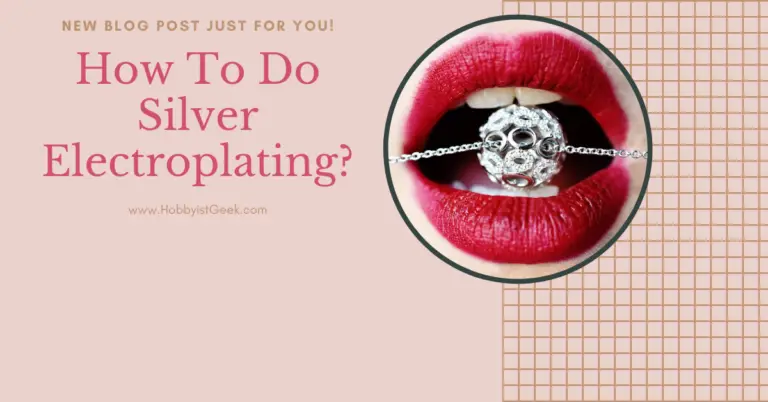Can Plastic Be Electroplated? Important
It is a relatively more accessible and straightforward process when we want to electroplate a conductive material, i.e., metals, etc.
When the piece that is being electroplated is conductive, the electroplating process moves smoother since the electrolyte reacts quickly with the conductive piece.
However, it is not the case when the piece that you want to electroplate is not conductive – plastic, for example.
The answer to the question CAN PLASTIC BE ELECTROPLATED?
Yes, plastic can be electroplated, but it is different from the way of electroplating metals.
The process of plastic electroplating involves painting plastic with conductive paint and then proceeding with the rest of the electroplating process.
What Is Electroplating On Plastic?
Electroplating is the process of depositing metal over another substance.
Since the plating requires the substance to be electrically charged, and plastic can’t be electrically charged directly, it is painted with conductive paint to electroplate it.
Plastic electroplating has been around for decades and people have been using it not just to make their plastic pieces decorative, but to also protect them from corrosion and breaking.

What Is The Difference Between Electroplating And Electroforming?
We have discussed the difference between electroplating and electroforming in detail in previous articles.
While both processes involve coating one metal over another, there are some fundamental differences between these two processes.
In electroplating, the deposited metal becomes a permanent part of the piece that has been plated via electrodeposition.
On the other hand, electroforming involves building layers of copper metal around a hard surface.
Electroplating On Plastics | Benefits Of Plating On Plastics
Plastic is electroplated for many reasons, and it is becoming quite popular over time.
This hobby-natured activity, which was only known to few people, is now a process that is recognized across the globe.
Some Of The Benefits Of Electroplating Plastics Are As Follows:
Plastics are mainly electroplated to create wear and corrosion resistance to give them a longer life by taking away their tendency to wear out and corrode.
Once the plastic is electroplated with a metal like copper, its surface becomes resistant to many corrosive chemicals and other materials that could damage its surface.
To Make Plastics Conductive:
Plastics are generally non-conductors of heat and electricity.
Thus, plating the plastics with conductive metals makes them conductors.
To create beautiful jewelry Pieces:
We electroplate plastic to turn it into beautiful jewelry and other forms of art.
This video explains How-To Make Metal: Electroplating a 3D Printed
The Process Of Copper Plating Of Plastics – Explained Step By Step
As discussed earlier, plastic needs to be painted with conductive paint for the electroplating process to start.
Naturally, plastic is not a conductor, and it will not react with the electroplating solution unless covered with conductive paint.
Here are the materials that you are going to need for the process:
- Super shield nickel conductive coating (https://amzn.to/2PNhIF8)
- Plug N Plate nickel & copper kit (https://amzn.to/2QEk4HX)
- Mother’s mag and aluminum polish (https://amzn.to/2Dc4uAn)
We will be plating on a plastic 3D material, and since we will be doing it with this technique called plating, it is important for you to not miss the steps listed here.
- Apply the Super shield nickel conductive coating (https://amzn.to/2PNhIF8) on the piece to be plated.
- Use sandpaper to smooth the piece to be plated.
- Touch up any areas missed with Nickel Print Conductive Paint (https://amzn.to/2xzHcyk) piece to be plated.
- After the paint is dried, start to electroplate the copper with Plug N Plate nickel & copper kit (https://amzn.to/2QEk4HX).
- Once the plating is done, polish the electroplated piece with Mother’s mag and aluminum polish (https://amzn.to/2Dc4uAn) to protect the piece.
After we have done all this, now you have our COPPER electroplated piece of jewelry.
The process doesn’t involve a lot of preparation since the Plug N Plate nickel & copper kit comes with everything that we need including the copper solution.
What Types Of Plastic Materials Can Be Electroplated?
ABS filament (Acrylonitrile butadiene styrene) is a thermoplastic polymer widely used for all metal plating plastic applications.
Along with ABS filament, one of the most popular material is PLA filament.
These two filaments are widely used as 3D printer filaments, and people who create pieces of art through electroplating and electroforming use these filaments.
PLA filament, especially, is safe to use and is affordable.
On the other hand, some of the plastic materials that are very difficult to electroplate are valox, polyester, nylon, and other non-blended plastics.
It is not impossible to electroplate these types of plastics, but the process to plate them is highly complex and challenging.
What Types Of Plastic Materials Can Be Electroplated?
Apart from plastics, wood, glass, and other organic materials can also be plated.
The process to plate them is similar to plating plastics, i.e., painting them with a conductive substance followed by the plating process discussed above.
What Are The Problems With Electroplating On Plastics?
Some of the common problems that arise after a piece of plastic is electroplated are:
Splay:
Although it is mainly molding issues that cause splay, it only becomes visible on the surface of plastics following the plating process.
Splay is generally a collection of marks and breaks on the plated part of the plastic.
Excess moisture on the plastic surface due to inadequate drying can also cause splay.
Flash Blisters, and Dents:
Flash occurs during the plating when the plastic piece protrudes from the edge of a part.
Similarly, blisters are caused during the plate due to air pockets on the surface of the plastic.
Dents are also driven on the plastic surface during plating because the texture is extraordinarily soft and fragile.
Skip plating, drying down, warping, and the appearance of white stains on the surface of plastics are also some of the other common problems with plating on plastics.
Plastic Plating With Metal Applications
You can electroplate all kinds of plastic materials that will protect them from corrosion.
Electroplating your plastic pieces will also ensure that they are less fragile and their surface becomes hard, thus protecting them from breaking.
Similarly, metallic plated plastic products have widely been used by hobbyists for decorative applications.
Hobbyists use plating for plastics to make decorative pieces of plastics by giving them an antique look in a variety of colors.
Final Thoughts On Can Plastic Be Electroplated?
Plating plastics have been around for decades, and the process has only improved over the years.
With new techniques and apparatus, it has become even more efficient, and you can easily electroplate plastics at home with simple steps.
Once you have learned plastic plating, you can use it to protect and enhance your favorite plastic pieces along with enjoying it as a hobby.
Electroforming: The Ultimate Guide Check It Out!
If your looking for more information on electroplating try this article Can You Electroplate With Vinegar And Hydrogen Peroxide? (Best Way)
Please let us know what you thought about this article Can Plastic Be Electroplated?

References
https://www.market-prospects.com/articles/electroplating-process-of-plastic-abs
https://www.sharrettsplating.com/base-materials/plastics
https://sciencing.com/electroplate-plastic-6168466.html
- Evil Eye Hand: Unveiling the Mystical Origins and Meanings - February 2, 2024
- Amegreen Amethyst Meaning: Discover the Hidden Magic! - February 2, 2024
- Is The Evil Eye Bad?: A Deep Dive into Evil Eye Taboos - February 2, 2024








